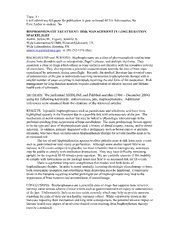
NASA Technical Reports Server (NTRS) 20070009988: Bisphosphonate Treatment: Risk Management in Long Duration Spaceflight PDF
Preview NASA Technical Reports Server (NTRS) 20070009988: Bisphosphonate Treatment: Risk Management in Long Duration Spaceflight
Topic I.1 I will submit my full paper for publication in peer reviewed ACTA Astronautica: No First Author is student: No BISPHOSPHONATE TREATMENT: RISK MANAGEMENT IN LONG DURATION SPACEFLIGHT Auñón, Serena M., Fogarty, Jennifer A. Wyle Laboratories/UTMB, Houston/Galveston, TX Wyle Laboratories, Houston, TX [email protected] or 281-212-1316 (fax) BACKGROUND and PURPOSE: Bisphosphonates are a class of pharmaceuticals used to treat diverse bone disorders such as osteoporosis, Paget’s disease, and multiple myeloma. They constitute a class of drugs which adhere to bony surfaces and interfere with the resorptive activity of osteoclasts. They also represent a potential countermeasure towards the loss of bone mass experienced by astronauts during spaceflight. Recently, the medical literature has revealed cases of osteonecrosis of the jaw in individuals receiving intravenous bisphosphonate therapy with a smaller number of cases occurring in individuals receiving the oral form of the medication. Risk management for long duration missions requires consideration of mission success and lifetime health care of astronauts. METHODS: We performed MEDLINE and PubMed searches (1966 – December 2006) using the following keywords: osteonecrosis, jaw, bisphosphonates. Additional references were obtained from the citations of the retrieved articles. RESULTS: Injectable bisphosphonates such as pamidronate and zoledronic acid have been highlighted recently in the literature due to a possible link with osteonecrosis of the jaw. The mechanism of action remains unclear but may be linked to physiologic microdamage in the jawbones resulting from suppression of bone metabolism. The most predisposing factors appear to be the type and dose of bisphosphonate used, a history of dental surgery, trauma, and/or dental infection. In addition, patients diagnosed with a malignancy such as breast cancer or multiple myeloma, who have been on intravenous bisphosphonate therapy for several months seem to be at increased risk. The use of oral bisphosphonates appears to place patients more at risk from acute events such as gastrointestinal tract injury or perforation. Although some studies report little to no increase in GI events compared to placebo, we must remember that in microgravity, astronauts may be unable to comply with medication instructions. They may have difficulty remaining upright for the required 30-45 minutes post-ingestion. We are currently unaware if this inability to comply with instructions on the package insert may lead to an increased risk for GI events. There is a potential long-term complication that resides with both forms of bisphosphonate therapy. In order to repair normally occurring physiologic microdamage to bone, both osteoclastic resorption and osteoblastic bone deposition must be functional. Controversy exists in the literature regarding whether prolonged use of bisphosphonates may lead to the suppression of bone turnover and accumulation of microdamage. CONCLUSIONS: Bisphosphonates are a powerful class of drugs that suppress bone turnover, but may cause serious adverse clinical events such as gastrointestinal tract injury or osteonecrosis of the jaw. Unfortunately, little to no data exists currently which may help us provide answers regarding the risks of their use in a healthy astronaut cohort. While controversy exists in the literature regarding their mechanism and long-term consequences, the potential mission impact or lifetime health care impact of an adverse clinical event resulting from bisphosphonate therapy must be considered.
